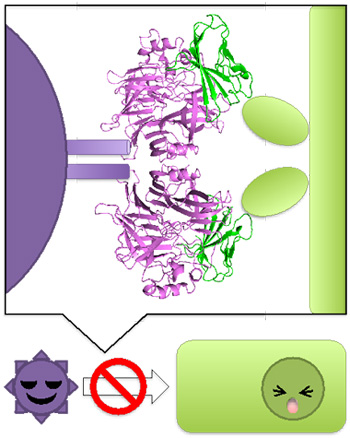<1> We aim to develop next-generation biomedicine (bio-fusion) by fusion innovation of “nucleic acid medicines” and “protein medicines” in the aspects of study and research.
Through this study we foster leaders of biochemical innovation and drug discovery toward next generation.
Here are three main pillars specialized in biomedical development for next generation
- Lectures at the graduate school: to hold lectures on total biomedicine
- Internship of industry-academic-government collaboration (domestic)
- Global education (collaboration with overseas universities, internship in companies, and lectures in English by foreign lecturers)
We'll establish educational programs on these points.

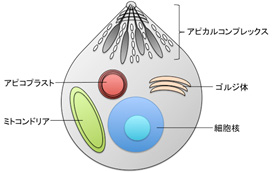
Figure 1 Diagram of plasmodium
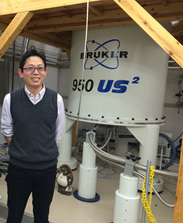
Figure 2 Collaborative research partner: NMR apparatus of Institute for Protein Research in Osaka University
<2> Malaria-causing protozoans belong to apicomplex division and have apicoprast, or second symbiosis plastid, surrounded by fourfold indusium and thought to be degenerated chloroplast. Most of protein used in apicoprast is first compounded in endoplasmic reticulum ,and then, forms complexes with a variety of membrane transport-related factor(protein group)and is carried to the inside of apicoprast. By means of structural biological study combined NMR spectral analysis(figure2) with X-ray crystallography, we aim to analyze the mechanism in the process of complex formation of “transit sequence and membrane transport-related factor” which is brought about in transferring protein to apicoprast. Apicoplast is a unique type of organelle, which apicomplex devision including plasmodium have. Here in the transportation of protein, there is a possibility of using molecular recognition mechanism, which cannot be observed in other species. As the plasmodium has such a unique cell organelle and biosynthetic reaction system of prokaryote type which is different from that of humans’ , to analyze the mechanism of transporting protein which is sent to apicoplast will help to find the possibilities to offer important information for the discovery of antimalarial drug that has less side effect on humans.
<3> We conduct structural study regarding interaction between surface receptor expressed in immune cells and ligand such as pathogen or self-protein. Furthermore, we search for new drug discoveries utilizing information from it.
- We analyzed the structures of CLR Mincle and MCL that are expressed mainly in antigen-presenting cell and that recognize glycolipid existing on the surface of tubercle bacillus. As a result, we made it clear that they recognize glicolipid in such a mechanism as isn't observed in other immune cell receptor. (Figure 1)
- Pair receptor(extracellural region has high rate of homology of amino acid, while, intracellular domain has ITAM/ITIM and conveys opposite signal) We study the structural analysis on the interaction with ligand.(Figure 2)
- Using structural information above, we conduct the development of new immunostimulator and inhibitor. Also, we advance the search for surface plasmon resorance, isothermal caloriemetry method, using biochemical and physico-chemical approaches.
Figure 1
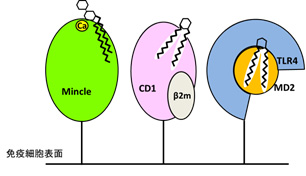
Figure 2
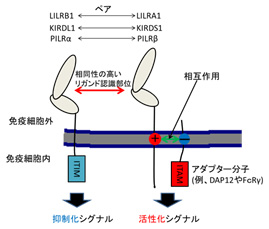
<4> Artificial oligonucleotides are promising candidates for future therapeutics due to their tendency to target specific disease-related genes. The first report of an oligonucleotide to silence a gene was revealed in 1978, when Zamenick and Stephenson discovered that a 13-mer synthetic oligonucleotide can inhibit the expression of Rous sarcoma virus 35S RNA. Recent advances in nucleic acid researches have generated large variety of molecules with interestingly unique properties that can be utilize to synthesize oligonucleotides with desirable properties. However, the successful application of oligonucleotides into therapeutics has remained challenging due to various problems like susceptibility towards serum nucleases, renal clearance, and non-specific biodistribution. In particular, the major problem in the development of siRNA therapeutics is the efficiency of the delivery system. Several efforts including viral vectors and non-viral vectors (like high pressure intravenous injection, liposomal formulation etc) have not met with great success and raised issues on safety of their use. My research interest is to develop an efficient ‘voyage’ by synthesizing a plausible siRNA bioconjugate for the targeted delivery of the artificial oligonucleotides into cells. Furthermore, I am interested to design and synthesize modified nucleosides, nucleotides and nucleic acids that would be applicable for various nucleic acid-based technologies and suitable for enhancing ‘drug-like properties’ of an oligonucleotide therapeutic such as enzymatic stabilities, binding to cellular and serum proteins, biodistribution, circulation life, and so on.
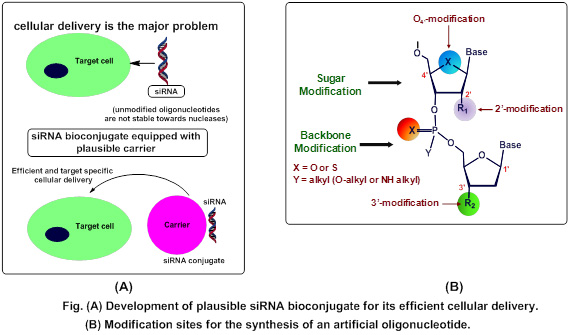
<5> Some kinds of viruses recognize specific molecules expressed in the target cells and then use them as their receptors when they invade host cells. For example, It has proved that measles virus and canine distemper virus, which are parts of morbillivirus, become infectious through SLAM expressed in immune cells and that they use Nectin4 of epithelial cells. To prevent them from infection, vaccine is very effective. But especially in developing countries where medical care is not sufficient, they don't have any effective methods of treatment. We minutely study the mechanism how viruses such as morbillivirus, influenza virus, herpes simplex virus, rabies virus, and HIV intrude into cells. We aim to develop such drugs as to stop expansion of the infection or the progression of diseases by hindering this process.
